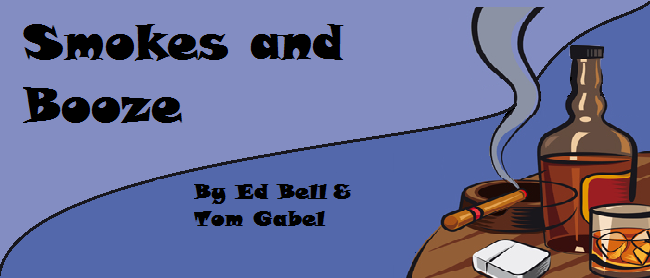HA – We won’t be destroying the Death Star anytime soon, but this is a good “Science” Article submitted by Mike (His 2nd and our 4th Reader Submission of the day). Time to break out the Gin….because Gin makes a man mean.
How to Make a Laser From a Gin and Tonic
Making a liquid laser requires patience, but yields the world's coolest party trick: Hit it with enough focused energy, and a gin and tonic can be transformed from a predictable beverage into a super-chic space-age libation.
It was the summer of 1969. Scientists in Rochester, N.Y., prepared to fire up an experimental laser. Everything was in place—from the cooling system to ensure the laser didn't burst into flames to the warning lights informing other researchers to stay away. It was in every way a typical day in a typical laser laboratory, except for one fact: On this day, the laser doubled as a gin and tonic.
"I'd heard stories about gin-and-tonic lasers for years, but couldn't find out anything definite about them," says laser researcher Stephen Wilk, who published an article on the history of edible lasers in Optics and Photonics News in 2009. He finally tracked down an Eastman Kodak advertisement dated June 1969 that announced Rochester researchers had built a laser from a "certain well-known brand of quinine water" used to make gin and tonics.
The ad invited "ambitious youngsters" interested in creating their own liquid laser to contact Bruce Burdick, who worked at Kodak at the time. Burdick is now retired and can't recall the exact circumstances around which the gin-and-tonic laser was built, but he remembers the adman who came up with the attention-grabbing copy. "Walter Lippman in the communications department had such a way with words," Burdick says. The advertisement was meant to generate buzz about lasers, which had been invented just nine years earlier. "I don't think people were that familiar with laser applications in the world like we are today," Burdick says.
There are countless ways to convert energy into coherent photons, and lasers come in many shapes, materials and sizes. To make something lase, you must have an intimate understanding of its atomic structure. That structure determines what type of energy is needed to prime it for lasing. Laser scientists dream of discovering brand-new laser materials—whether gas, solid or, yes, even liquid. Edible-laser pioneer Theodor Hänsch once said, "Anything will lase if you hit it hard enough," and to prove his point, he partnered with Arthur Schawlow in 1970 to build lasers out of a gelatin-and-dye mixture very similar to Jell-O.
As for gin-and-tonic lasers, another great milestone occurred in 1975 in Boulder, Colo., at the National Bureau of Standards. Scientists there made lasers out of vodka, rum and gin—but the lasers didn't produce much power. "There are better uses for ethyl alcohol," wrote the scientists in the IEEE Journal of Quantum Electronics.
Research into the gin-and-tonic laser has not progressed much in recent decades, but the liquid legend remains for today's ambitious youngsters—or enterprising adults—to re-create. Getting it to work probably won't win you a Nobel Prize, but it might help you toward that PhD in laser physics. Here are a few key steps to taking up that challenge.Step One: Energy
A laser requires energy to operate, but it's not always as easy as plugging one into a wall socket. The gin-and-tonic laser would have to be powered, or pumped, by other lasers. During the 1975 experiment in Boulder, researchers pumped straight gin using a 20-watt carbon-dioxide laser, which is 4000 times more powerful than a 0.05-watt laser pointer. CO2 lasers are used regularly in medical procedures, such as laser eye surgery and skin resurfacing treatments. You can buy a used one for several thousand dollars, but it's also possible to build a cheap one in your basement. Unfortunately, as the researchers noted, gin doesn't make the most powerful laser: With 20 watts of carbon dioxide laser light, they could only produce 0.00001 watts of coherent gin laser light.Step Two: Reflection
Every laser employs two mirrors that trap energy inside the gain medium—in this case, the gin and tonic. The Boulder researchers who lased gin set up two copper mirrors at either end of a copper tube. Energy builds up inside the drink until the molecules get excited enough to release photons. A small hole in one of the mirrors allows the laser light to escape. Gin produces light in the far infrared end of the spectrum, at 393 microns. It is invisible to the human eye, so a special detector made out of gas is needed to "see" the photons.Step Three: Coupling
Lasers are tricky beasts; painstaking and meticulous alignment is usually required to get them to work. Just having a source of energy and mirrors to trap it isn't enough: You'll also need a focusing lens to couple light from the carbon dioxide laser into the gin and tonic. It can sometimes take days, weeks or even months to get a material to lase for the first time. Everything must be adjusted to fall within a wavelength—which in this case is equal to the thickness of a few strands of hair or a tiny bubble in your drink.
Once these three steps have been executed perfectly, the gin in your drink will begin to lase—at which point all of the meticulous effort will be worth it. After all, while it may be weak and invisible, how many people can say they drank a laser?
Caution: Lasers can damage the eye with prolonged exposure, even at laser pointer–class power levels. Any laser experiment should be conducted by trained professionals who have a proper understanding of the dangers of lasers—and a good pair of laser safety goggles.






No comments:
Post a Comment